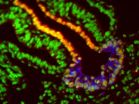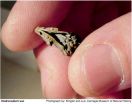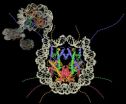(Press-News.org) A human genetic variant associated with an almost 30 percent reduced risk of developing severe malaria has been identified. Scientists from the Bernhard Nocht Institute for Tropical Medicine (BNITM), Hamburg, and Kumasi University, Ghana, reveal that a variant at the FAS locus can prevent an excessive and potentially hazardous immune response in infected children. The study appears in the open-access journal PLoS Genetics on May 19.
Severe malaria is a major public health burden in Sub-Saharan Africa, where approximately one million individuals die each year as a result of infection with Plasmodium falciparum. Whereas adults in endemic areas develop some resistance to malaria, preventing severe complications, children under the age of five years can develop life-threatening forms of the disease. To date, the molecular mechanisms causing these manifestations are poorly understood.
FAS encodes for CD95, a molecule critically involved in the programmed death of some white blood cells. This candidate gene study, including more than 6,000 child subjects, details how a single nucleotide variant of FAS predisposes its carriers to a higher number of immune cells prone to suicide. These findings indicate that a genetic predisposition to an increased expression of CD95 may help to protect from severe malaria, possibly by rendering a type of white blood cell more susceptible to programmed cell death.
Kathrin Schuldt, co-author, said, "We believe that our study will help to unravel the mechanisms causing the fatal forms of malaria."
###
FINANCIAL DISCLOSURE: The work was supported by the German National Genome Research Network (NGFN; www.ngfn.de). The funders had no role in study design, data collection and analysis, decision to publish, or preparation of the manuscript.
COMPETING INTERESTS: The authors have declared that no competing interests exist.
CITATION: Schuldt K, Kretz CC, Timmann C, Sievertsen J, Ehmen C, et al. (2011) A 2436C.A Polymorphism in the Human FAS Gene Promoter Associated with Severe Childhood Malaria. PLoS Genet 7(5): e1002066. doi:10.1371/journal.pgen.1002066
CONTACT: Kathrin Schuldt, PhD
0049-40-42818-523
schuldt@bnitm.de
Disclaimer
This press release refers to an upcoming article in PLoS Genetics. The release is provided by journal staff, or by the article authors and/or their institutions. Any opinions expressed in this release or article are the personal views of the journal staff and/or article contributors, and do not necessarily represent the views or policies of PLoS. PLoS expressly disclaims any and all warranties and liability in connection with the information found in the releases and articles and your use of such information.
About PLoS Genetics
PLoS Genetics (http://www.plosgenetics.org) reflects the full breadth and interdisciplinary nature of genetics and genomics research by publishing outstanding original contributions in all areas of biology. All works published in PLoS Genetics are open access. Everything is immediately and freely available online throughout the world subject only to the condition that the original authorship and source are properly attributed. Copyright is retained by the authors. The Public Library of Science uses the Creative Commons Attribution License.
About the Public Library of Science
The Public Library of Science (PLoS) is a non-profit organization of scientists and physicians committed to making the world's scientific and medical literature a freely available public resource. For more information, visit http://www.plos.org.
Malaria risk reduced by genetic predisposition for cell suicide
Press release from PLoS Genetics
2011-05-20
ELSE PRESS RELEASES FROM THIS DATE:
Sniff sniff: Smelling led to smarter mammals, researchers say
2011-05-20
A rose by any other name would smell as sweet; the saying is perhaps a testament to the acute sense of smell that is unique to mammals. Paleontologists have now discovered that an improved sense of smell jumpstarted brain evolution in the ancestral cousins of present-day mammals. The research will appear in the 20 May 2011 issue of the journal Science, which is published by AAAS, the international, nonprofit science society.
The findings may help explain why mammals evolved such large and complex brains, which in some cases ballooned 10 times larger than relative body ...
Mammals first evolved big brains for better sense of smell
2011-05-20
Mammals first evolved their characteristic large brains to enable a stronger sense of smell, according to a new study published this week in the journal Science by paleontologists from The University of Texas at Austin, Carnegie Museum of Natural History and St. Mary's University in San Antonio.
This latest study is the first to use CT technology, similar to medical scanners, to reconstruct the brains of two of the earliest known mammal species, both from the Jurassic fossil beds of China. The 3D scans revealed that even these tiny, 190-million-year-old animals had developed ...
Predicting the fate of personalized cells next step toward new therapies
2011-05-20
PHILADELPHIA – Discovering the step-by-step details of the path embryonic cells take to develop into their final tissue type is the clinical goal of many stem cell biologists.
To that end, Kenneth S. Zaret, PhD, professor of Cell and Developmental Biology at the Perelman School of Medicine at the University of Pennsylvania, and associate director of the Penn Institute for Regenerative Medicine, and Cheng-Ran Xu, PhD, a postdoctoral researcher in the Zaret laboratory, looked at immature cells called progenitors and found a way to potentially predict their fate. They base ...
Large brains in mammals first evolved for better sense of smell
2011-05-20
Pittsburgh, Pennsylvania… Paleontologists have often wondered why mammals—including humans—evolved to have larger brains than other animals. A team of paleontologists now believe that large brains may have developed in mammals to facilitate an acute sense of smell, according to a new paper published today in the prestigious journal Science. The team also noticed enlargement in the areas of the brain that correspond to the ability to sense touch through fur; this sense is acutely developed in mammals.
Scientists used high-resolution CT scans to study rare 190-million-year-old ...
Death of Osama bin Laden Highlights Importance of the Zadroga Act, Says New York Personal Injury Lawyer
2011-05-20
After the death of Osama bin Laden, New York personal injury lawyer David Perecman reaffirmed his commitment to help the heroes who are still battling illnesses connected to 9/11.
For many individuals, the death of bin Laden brought closure. The death also served to rekindle memories of those who volunteered to assist at the World Trade Center site after the 9/11 attacks.
The lives of many Ground Zero volunteers were changed in challenging ways. Rescue and recovery workers and others are still suffering from health consequences related to the World Trade Center disaster.
"People ...
Scientists discover new drug target for squamous cell carcinoma
2011-05-20
SEATTLE – Researchers at Fred Hutchinson Cancer Research Center have discovered a new drug target for squamous cell carcinoma – the second most common form of skin cancer. Scientists in the laboratory of Valeri Vasioukhin, Ph.D., have found that a protein called alpha-catenin acts as a tumor suppressor and they also have unlocked the mechanism by which this protein controls cell proliferation.
The findings by Vasioukhin and colleagues will be published May 24 in Science Signaling.
For the study, the researchers studied mice that were bred to lack a copy of the gene that ...
Packaging process for genes discovered in new research
2011-05-20
Scientists at Penn State University have achieved a major milestone in the attempt to assemble, in a test tube, entire chromosomes from their component parts. The achievement reveals the process a cell uses to package the basic building blocks of an organism's entire genetic code -- its genome. The evidence provided by early research with the new procedure overturns three previous theories of the genome-packaging process and opens the door to a new era of genome-wide biochemistry research. A paper describing the team's achievement will be published in the journal Science ...
Senators Want DUI Applications Removed From Smartphones
2011-05-20
In March, four Democratic U.S. Senators, Harry Reid, D-Utah, Chuck Schumer, D-N.Y., Frank Lautenberg, D-N.J., and Tom Udall, D-N.M., drafted a letter requesting that Apple, Google and Research in Motion (or RIM) eliminate the applications (user-friendly computer programs for specific tasks) on mobile communication devices that warn drivers of the locations of drunk-driving checkpoints.
The next day, RIM, the manufacturer of the BlackBerry agreed to the removal of driving-under-the-influence (DUI/DWI) checkpoint functionality on its BlackBerry devices.
Google later ...
What Causes the Metal Skin on an Airliner to Tear Apart?
2011-05-20
On Friday, April 1, 2011, a Southwest Airlines Boeing 737-300 experienced a rapid decompression when the metal fuselage skin tore apart, leaving a 5X1 foot hole. This kind of event is rare, but can, and has been, catastrophic when it does occur.
In 1988, another Boeing 737, a 200 model, experienced a similar, but much worse, event over Hawaii. In that case, the skin on the entire front section of the aircraft cabin was denuded, leaving the passengers sitting in the first several rows completely exposed, with the aircraft being held together by two metal spars running ...
Of frogs, chickens and people
2011-05-20
Researchers at the University of California, San Diego School of Medicine have uncovered new details of an unusual biological mechanism in the brains of diverse species that not only helps regulate how their brains develop, but also how they function later in life. The discovery could lead to new biomarkers for specific neurological diseases in humans and, possibly, the development of drugs to cure them.
The research, by Miles F. Wilkinson, PhD, professor of reproductive medicine and a member of the UCSD Institute for Genomic Medicine, and colleagues, is published in ...
LAST 30 PRESS RELEASES:
Making lighter work of calculating fluid and heat flow
Normalizing blood sugar can halve heart attack risk
Lowering blood sugar cuts heart attack risk in people with prediabetes
Study links genetic variants to risk of blinding eye disease in premature infants
Non-opioid ‘pain sponge’ therapy halts cartilage degeneration and relieves chronic pain
AI can pick up cultural values by mimicking how kids learn
China’s ecological redlines offer fast track to 30 x 30 global conservation goal
Invisible indoor threats: emerging household contaminants and their growing risks to human health
Adding antibody treatment to chemo boosts outcomes for children with rare cancer
Germline pathogenic variants among women without a history of breast cancer
Tanning beds triple melanoma risk, potentially causing broad DNA damage
Unique bond identified as key to viral infection speed
Indoor tanning makes youthful skin much older on a genetic level
Mouse model sheds new light on the causes and potential solutions to human GI problems linked to muscular dystrophy
The Journal of Nuclear Medicine ahead-of-print tip sheet: December 12, 2025
Smarter tools for peering into the microscopic world
Applications open for funding to conduct research in the Kinsey Institute archives
Global measure underestimates the severity of food insecurity
Child survivors of critical illness are missing out on timely follow up care
Risk-based vs annual breast cancer screening / the WISDOM randomized clinical trial
University of Toronto launches Electric Vehicle Innovation Ontario to accelerate advanced EV technologies and build Canada’s innovation advantage
Early relapse predicts poor outcomes in aggressive blood cancer
American College of Lifestyle Medicine applauds two CMS models aligned with lifestyle medicine practice and reimbursement
Clinical trial finds cannabis use not a barrier to quitting nicotine vaping
Supplemental nutrition assistance program policies and food insecurity
Switching immune cells to “night mode” could limit damage after a heart attack, study suggests
URI-based Global RIghts Project report spotlights continued troubling trends in worldwide inhumane treatment
Neutrophils are less aggressive at night, explaining why nighttime heart attacks cause less damage than daytime events
Menopausal hormone therapy may not pose breast cancer risk for women with BRCA mutations
Mobile health tool may improve quality of life for adolescent and young adult breast cancer survivors
[Press-News.org] Malaria risk reduced by genetic predisposition for cell suicidePress release from PLoS Genetics



